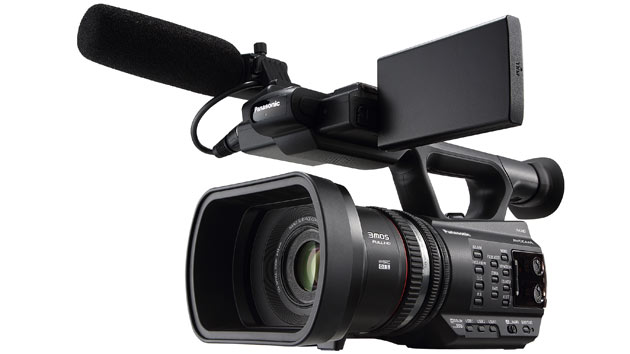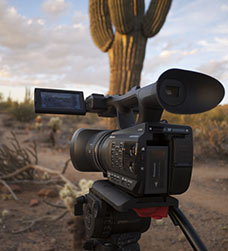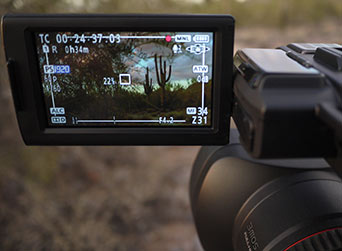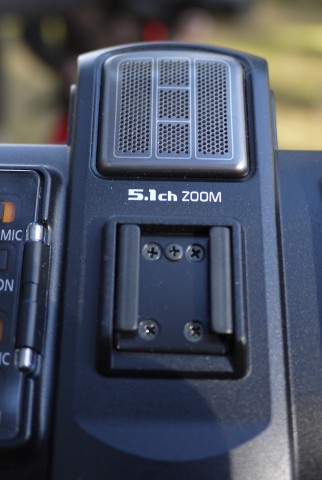This Compact Camcorder Is an Under-Recognized Hero

Last year, the Panasonic AG-AC90 was introduced to little fanfare or notice. This lack of attention may have been due to the modest camera's small sensor, which, in an era of 4K workflows and Ultra HD displays, is hardly a motivation for shooting off fireworks and wild celebrations. The dearth of chatter might also be attributable to the camera’s notable lack of pretense; the camera is intended primarily for the most unglamorous applications in education, corporate, and the legal worlds. Then there is the poor Panasonic marketing effort (or complete absence thereof). Whatever the ultimate reason for the camera's lack of celebratory spark, the AC90 is a beautifully designed compact camcorder offering superb performance and operational efficiency at a remarkably low price.
The first thing one notices is the camera is very well-balanced. This is no small matter, as a poorly weighted camera can contribute to operator fatigue at the end of a long shooting day — and many missed shots. Placing the camera in the palm of the hand with one’s fingers extended forward to the controls, the camera sits perfectly allowing easy follow-focus, pans and tilts, with the help of a better-than-average high-resolution LCD viewfinder borrowed from the company’s higher-end models.
The camera is fitted with three 1/4-inch MOS sensors, and that's the mostly likely reason for the lack of enthusiasm on blog sites and in the media in general. While the configuration is ideal for most nonfiction and documentary programs, it flies in the face of the current vogue to employ a large sensor, regardless of the wisdom or practicality of such a choice with respect to focus, lens options, speed of operation and workflow. Defying the current mindset, I prefer a smallish imager for unscripted shows and fast action sports like NASCAR, where the increased depth of field is critical to capturing sharp images at the end of a long telephoto zoom. The trade-off, of course, is the reduced dynamic range and low light capability. The AC90 tends to struggle with the deepest shadows, given the camera’s diminutive sensor.
The 12X f1.5-2.8 integrated zoom with the 35mm SLR-equivalent wide angle of 29.8mm provides decent, if not great, coverage with little apparent barrel distortion and chromatic aberrations. This is a key advantage of compact camcorders fitted with non-interchangeable lenses: the camera compensates internally for the most egregious defects in the low-cost optics, resulting in much better performance and quality of images than one might otherwise reasonably expect.
With a tiny sensor, this camera was never intended for landscapes and broad vistas. Nevertheless, the results can be impressive for scenes exhibiting a relatively narrow dynamic range.
The AC90 chassis constructed of aviation-grade magnesium alloy allows superior heat dissipation and is particularly rugged for such a low-cost camcorder. The chassis was originally designed for Panasonic’s 3D Z10000 camera, and is thus notably fitted with a 3/8-inch mounting socket. This means the camera can be secured to the industry’s most professional support gear, including robust jib arms and cranes. I like that the AC90 can play nicely with whatever large support systems I might have working on a job.
The camera notably records 1080p60 AVCHD in PS mode at 28 Mbps. This is the highest AVCHD bit rate implemented to date and is a bit of an anomaly. For the unfamiliar, AVCHD is a high-performance prosumer format that is long-GOP, which means in exchange for the higher interframe compression and 4:2:0 8-bit color, the camera's output can be captured to an inexpensive SDXC/SDHC/SD card, reducing media and storage costs. As in previous codec implementations, editing AVCHD directly in the NLE should be avoided; it can be extremely processor-intensive. That means, one way or the other, you'll likely be transferring the original camera files to a more editing-friendly codec like ProRes or DNxHD.
Interestingly, the camera features nifty 5.1-channel Dolby Digital recording capability, a carryover feature, no doubt, from the 3D Z10000. That means the camera can serve as an ersatz surround-sound audio recorder for low-budget feature films and short subjects. By the way, the audio section is notably quiet for a camera at this price point, with dual-XLR balanced inputs and better-than-average low-noise preamps.
The AC90 doesn’t pretend to be more than it is, and that is a well-designed camera with precise color and a boatload of professional features (including 24p). You’ll never shoot the new Harry Potter or Lawrence of Arabia with the Panasonic AG-AC90, but for most of the projects we shoot every day in the nonfiction, sports, and documentary realms, the AC90 is an excellent alternative to the operational and performance challenges of the DSLR.
Did you enjoy this article? Sign up to receive the StudioDaily Fix eletter containing the latest stories, including news, videos, interviews, reviews and more.
More reviews













I have purchased 20 of these cameras for the students of TCU’s school of journalism to use and I can say they perform remarkably for their price point.
Jim, Glad to see this is what you went with at TCU. We have 21 HMC 150s and are buying 6 of these for our intro to Digital Media Class at Valencia College.
1/4 inch sensor is ideal for nothing! Seriously. No one wants a camera these days that can’t use other lenses. That doesn’t shoot 24p….BMD pocket cinema camera blows it away. no contest. Panasonic probably had leftover parts at the factory and wanted to see how many suckers would buy an old camera with a firmware update. 28mbps! wow! A GH3 does that!
The needs of a university journalism school are not necessarily those of a freelance videographer or filmmaker. An educational institution may be looking for a camcorder that is compatible with it’s current editing software. Also, they may be looking for something that has the features of an ENG camera (XLR inputs, physical switches and dials for the most important controls), rather than a camera designed for digital cinema. BTW, this camera does shoot 24p (not that 24p is necessarily desirable for a journalism school), it just isn’t mentioned in this article.
I agree, Wheeler, plus something like the BMD or GH3 brainburst references would be useless for run-n-gun work or most documentary uses except for those shot in-studio, and for ENG either as a stringer or as a backup for the big ENG cams.
Two completely different markets.
I’m getting so tired of these superior attitude of Some dslr and bmc users. Video deels more to mee thans hugenoot sponsors and Dof.
What an ignorant post. And I’m a large sensor guy myself
I have been shooting professionally (Dateline NBC, national docs, corporate, etc) for roughly 20 years and this camera is amazing. I also use a Canon 70D and while it does create better bokeh, the 90 is my first choice for run and gun documentary shoots. I can pick it up and start recording quickly and never miss a moment. The auto features are amazingly spot on and the pictures and crisp and sharp. The stabilizer is off the charts and it’s surprisingly good in low light. It’s also professional looking as well and that can be important to the client — not too big or small. Thanks for your great review, Barry!
When I shoot an interview on 5DmkII, I get an amazing image quality at low light. However, the only way it works well is if the person I’m interviewing is sitting more-or-less still. If (s)he moves even a little back-and-forth, his face moves in and out of focus. There is absolutely NO WAY I can follow him with focus, and even less of a chance to ask him not to move.
Over the past year, 5DmkII has largely been an exercise in frustration, occasionally interrupted by the visual bliss of amazing image quality.
With AC90, all that went away. I no longer need to worry about focus, I can direct my attention to more important stuff. The “HG3 costs almost $1400; for $400 more, I get an actual video camera; not a still camera with video recording capability.
The original post is truly arrogant.
This is a remarkable camera. For the price you can’t get a 5 year old camera as good as this one . I have a panasonic GH3 and Panasonic AF100 combo. The AC90 is on a different category Not to be compared with DSLR etc. This is the shut up and shoot right now canera. Not the wait let me change lens or let me record audio first . I live this camera. Even thought its front heavy for most tripod. But that that can be fixed with a manfrotto long sliding tripod plate adapter
Yah, a 1/4″ sensor seems a bit 1998 in this day and age. I totally agree that full frame and super35 sensors have their time and place. I believe very firmly in cameras are tools – pick the right one for the job. But I’m really surprised this isn’t a 1/3″ or 1/2″ at least. 1/4″ just seems so… old. 🙂
hi guy’s, i own this camcorder, i buy one in 2013 and is the best buy i ever made, its better like sony ax2000, the sound amazing, cristal clear image, for jurnalism, documentary, events, it is a good value, i use this camcorder and a canon D-slr for wedding , take a look here https://www.youtube.com/watch?v=nVndxy6zTKk&list=UUnfxzysQipT8n5wt7qN4Q2w&feature=c4-overview
I primarily use two HMC40s for shooting but actually think the AC90 is a better option. I wrote a full review on my blog explaining why for those interested:
http://www.camcorderchris.com/panasonic-ac90-professional-camcorder-review/
Chris